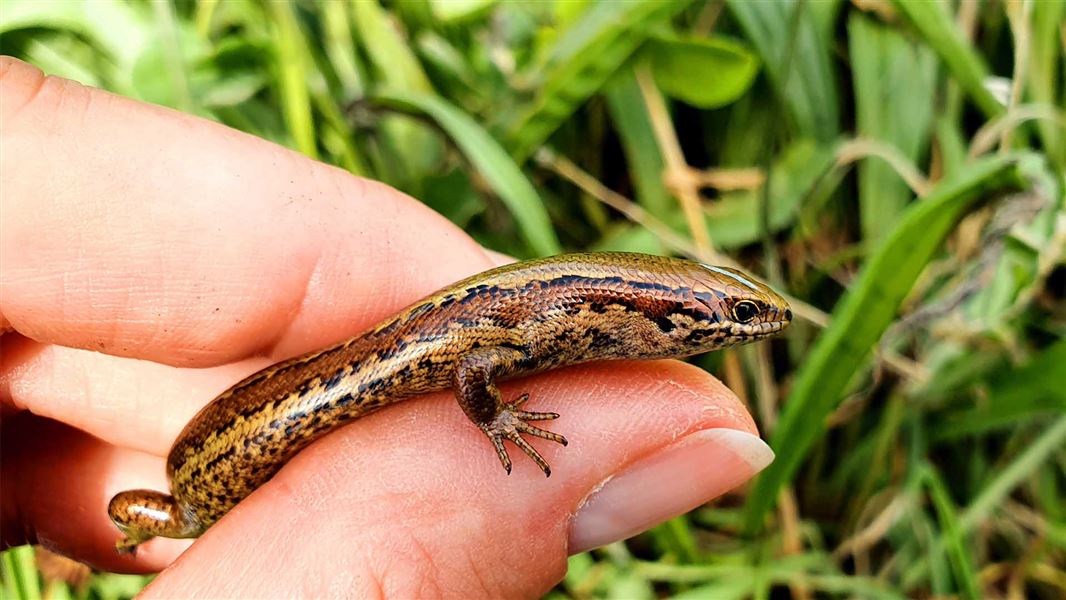Archived content: This media release was accurate on the date of publication.
Date: 26 November 2021
The Kapitia skinks, found only in a 1 km coastal strip near Hokitika, were badly impacted by Cyclone Fehi in 2018 with 50 skinks taken in by Auckland Zoo at the time.
The skinks have a salmon-coloured prehensile tail which they use to grip objects and help them climb. Researchers think they were adapted to climbing trees.
DOC Hokitika Operations Manager Owen Kilgour says 42 of the skinks now in the reserve travelled back this week on an Air New Zealand flight from their temporary home at Auckland Zoo.
“Cyclone Fehi devastated 40 percent of their habitat in 2018 and it’s likely many skinks were displaced or killed. We had to ensure the species survived and asked Auckland Zoo for help. They took 50 skinks at short notice and have done an amazing job of caring for them, as well as breeding 15 additional animals from them.
“Altogether there are fewer than 300 Kapitia skinks remaining in the wild. As well as threats to their habitat from storm damage, they’re vulnerable to predators such as mice, which attack them if they are too cold to move and eat them alive.
“We knew after Cyclone Fehi that we’d have to establish a safe home for the skinks if they were to survive and we now have that in the Kapitia Scientific Reserve.”
The reserve is a 1.3 ha piece of land within the range of the Kapitia skinks. There is a 1.8 m high predator proof fence around it and the adjacent small piece of road reserve. The reserve was declared predator free in late October.
“Over the past few days DOC staff have gathered about another 60 Kapitia skinks from the wild to add to those from Auckland Zoo,” Owen Kilgour says.
“It’s very exciting to see the reserve. We want to thank all those who’ve contributed to this achievement.
“My colleague Shane Hall, who’s the Greymouth Operations Manager, first spotted the skinks in 1992 on land he owned at the time. He realised they were different from other skinks and really started this process.
“DOC’s lizard technical advisory group has been a huge support for this project from the start and I’m really grateful for the dedication of our Hokitika staff.
“Auckland Zoo has also done a fantastic job.”
The Zoo’s ectotherms specialists say it’s been a privilege to be able to care for, and successfully breed, this rare taonga, as part of a team effort to help ensure the species’ future.
“It was with great excitement our ectotherms team packed up 42 of the skinks for their journey south for release into the new Kapitia Scientific Reserve,” says Auckland Zoo’s Head of Animal Care & Conservation and herpetologist, Richard Gibson.
“As a conservation science organisation, utilising our intensive management skills to benefit wildlife like this is what we all live for. Here at the Zoo, we’re still caring for three juveniles (too young to be released yet), as well as 20 gravid females, who with their offspring will in time also be released to further boost the Kapitia skink population.”
Owen Kilgour paid tribute to the specialist fencers who worked at the reserve under some wet and trying conditions. This included wrangling 3.6 m-long poles and heavy mesh in mud and rain.
“We want to acknowledge Ngāti Waewae and local landowners too for their support of this project and Westland District Council, which allowed the road reserve to be used,” he says.
The skinks travelled with Air New Zealand from Auckland to Hokitika via Christchurch on Wednesday.
Air New Zealand is DOC's National Partner for Conservation and has supported DOC to fly over 4,000 native animals and conservation dogs since 2012.
Kapitia skinks were formerly known as Chesterfield skinks, referring to the locality in which they were found. Māori know the area as Kapitia and in November 2020 the skinks were named the Kapitia skink.
The official opening of the reserve was scheduled for tomorrow but has been postponed due to a severe weather watch for Westland.
Contact
For media enquiries contact:
Email: media@doc.govt.nz
